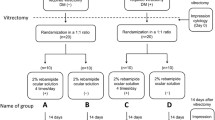Abstract
Purpose: The effect of antiglaucomatous agents on conjunctiva used for various durations evaluated histopatho-logically. Methods: Conjunctiva biopsies were taken in 19 Mayis University Faculty of Medicine Ophthalmology Department from 31 eyes of 30 patients who underwent filtration surgery after a period of antiglaucomatous agent use and examined under light microscope. The results were compared with the results of conjunctival biopsies from 10 similar aged patients undergoing retinal detachment of cataract surgery and with no other ocular pathology. Results: Five of the cases were using antiglaucomatous treatment for two months (Group A), four cases for two to 12 months (Group B) and 22 cases for more than 12 months (Group C) before the surgery. Four cases were using a beta blocker only, eight cases beta blocker + sympathomimetic or beta blocker + myotic and the remaining 19 cases were using a combination of beta blocker + sympathomimetic + myotic. Histopathologic evaluation with light microscope showed no pathologic change in group A, but, subepithelial increase of lymphocytes, mast cells, macrophages and fibroblasts in group C. Conclusion: It was detected that subconjunctival inflammatory reaction increases as the number of antiglaucomatous agents and the treatment duration increase. These changes might be considered as risk factors that decrease the success rate of filtration surgery.
Similar content being viewed by others
References
Jay JL, Murray SB. Early trabeculectomy versus conventional management in primary open angle glaucoma. Br J Ophthalmol 1988; 72: 881–9.
Watson PG, Grierson I. The place of trabeculectomy in the treatment of glaucoma. Ophthalmology 1981; 88: 175–96.
Glaucoma Laser Trial Research Group. Acute effects of argon laser trabeculoplasty on intraocular pressure. Arch Ophthalmol 1989; 107: 1135–42.
Derous D, De Keizer RJ, De Wolff-Rovendaal D, Soudijn W. Conjunctival keratinization an abnormal reaction to an ocular beta-blocker. Acta Ophthalmol (Copenh.) 1989; 67: 333–8.
Brandt JD, Wittpenn JR, Katz LJ, Steinmann WN, Spaeth LG. Conjunctival impression cytology in patients with glaucoma using long-term topical medication. Am J Ophthalmol 1991: 112: 297–301.
Gerstenberger A, Marquardt R. Die Becherzelldickte unter Pilocarpineinfluβ[The density of goblet cells modified by pilocarpine]. Fortschritte der Ophthalmologie 1986; 83: 46–50.
Takahashi N: Cytotoxic effects of antiglaucoma agents on cultured human conjunctival cells (author's transl.). Nippon Ganka Gakkai Zasshi Acta Societatis. Ophthalmologicae Japonicae 1981; 85: 1046–52.
Sherwood MB, Grierson I, Millar L, Hitchings RA. Long-term morphologic effects of antiglaucoma drugs on the conjunctiva and Tenon's capsule in glaucomatous patients. Ophthalmology 1989; 96: 327–35.
Wright P. Squamous metaplasia or epidermalization of the conjunctiva as an adverse reaction to topical medication. Trans Ophthalmol Soc UK 1979; 99: 244–6.
Lavin MJ, Wormald RPL, Migdal CS, Hitchings RA. The influence of prior therapy on the success of trabeculectomy. Arch Ophthalmol 1990; 108: 1543–8.
Abdel-Khalek LMR, Williamson J, Lee WR. Morphological changes in the human conjunctival epithelium. I. In the normal elderly population. Br J Ophthalmol 1978; 62: 792–9.
Leibovich SJ, Ross R. The role of the macrophage in wound repair: a study with hydrocortisone and antimacrophage serum. Am J Pathol 1975; 78: 71–91.
Wasserkrug HL, Efron G. Lymphocyte participation in wound healing: morphologic assessment using monoclonal antibodies. Ann Surg 1987; 206: 25–9.
Wahl SM, Allen JB. T lymphocyte-dependent mechanisms of fibrosis. Prog Clin Biol Res 1988; 266: 147–60.
Kovacs EJ, Kelley J. Lymphokine regulation of macrophage-derived growth factor secretion following pulmonary injury. Am J Pathol 1985; 121: 261–8.
Broadway DC, Grierson I, O'Brien Colm, Hitchings RA. Adverse effects of topical antiglaucoma medication I. The conjunctival cell profile. Arch Ophthalmol 1994; 112: 1437–45.
Herreras JM, Pastor JC, Calonge M, Asensio VM. Ocular surface alteration after long-term treatment with an antiglaucomatous drug. Ophthalmology 1992; 99: 1082–8.
Schwab IR, Linberg JV, Gioia VM, Benson WH, Chao GM. Foreshortening of the inferior conjunctival fornix associated with chronic glaucoma medications. Ophthalmology 1992; 99: 197–202.
Young TL, Higginbotham EJ, Zou X, Farber MD. Effects of topical glaucoma drugs on fistulized rabbit conjunctiva. Ophthalmology 1990; 97: 1423–7.
Author information
Authors and Affiliations
Rights and permissions
About this article
Cite this article
Aritürk, N., Öge, İ., Baris, S. et al. The effects of antiglaucomatous agents on conjunctiva used for various durations. Int Ophthalmol 20, 57–62 (1996). https://doi.org/10.1007/BF00212947
Issue Date:
DOI: https://doi.org/10.1007/BF00212947




